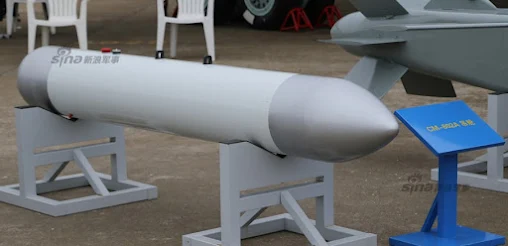When the United States and NATO have anti-ship missiles launched from fighter jets, such as the AGM-84 Harpoon and AM-39 Exocet, China, which has expansion ambitions and potential conflicts with countries in the disputed South China Sea, has also prepared missiles.
Anti-ship missiles that can be launched from fighter and bomber platforms. One of them is the KongDi (KD)-88, which was recently exhibited as a weapon on the JH-7A Flying Leopard fighter-bomber.
Read; Roketsan (Turkey) Launches “ÇAKIR” – Anti-Jamming Multi-Platform Anti-Ship Cruise Missile Family
From the post on the Twitter account @EK_Valensvek, the JH-7A Flying Leopard is shown in a static demo at the Changchun Airshow. Both the JH-7A and the KD-88 anti-ship missile, are not a new defense weapon arsenal for the Chinese military.
Like the KD-88 missile developed and produced by the China Aerospace Science and Technology Corporation (CASC), its variant has been in use by the Chinese Air Force since November 2006. While the JH-7A Flying Leopard made its maiden flight on December 14, 1988.
Especially about the KD-88, many analysts think that this anti-ship missile will play a key role in the early stages of China's invasion of Taiwan, because the KD-88 can be launched from various Chinese fighter jets, in addition to the JH-7A, the KD-88 can be launched from Shenyang J-16/J-15 multirole fighter jets, Chengdu J-10 and H-6 series bombers.
The export version of this missile is called the TL-7 and like the Harpoon and Exocet, the KD-88 is also available in land and naval variants. The KD-88 is powered by a turbojet engine with a cruising speed of Mach 0.85, and a range of up to 200 Km. The basis for the development of the KD-88 is the YJ-83/C-802 anti-ship missile.
The KD-88 generation adopted a radar guidance system, but later replaced it with a TV guidance system. Because it relies on TV guides, a data link system is needed. For data exchange, the pilot can view the image returned by the camera on the warhead via the cockpit screen, and select a target or strike a weak target part. The latest variant of the KD-88 now uses an infrared imaging guidance system.
Untested on the battlefield, the KD-88 design is considered to have a number of shortcomings, such as low stealth performance. The KD-88 still retains the cylindrical body of the YJ-83, which is easily detected by enemy radar.
 |
| CM-8002A guidance pod |
The internal chambers of the cylindrical body are irregular. It is difficult to achieve modularity and it is difficult to replace warheads, plus there is difficulty in handling different targets, and the flexibility of use is reportedly not very good.
From the specifications, the KD-88 has a length of 4.7 meters, a diameter of 0.32 meters, and a weight of 600 kg. The KD-88 warhead weighs 165 kg. Operational KD-88 on the JH-7A Flying Leopard fighter jet is supported by a data link pod, namely the CM-8002A guidance pod, which is also seen mounted under the fighter fuselage.
Follow Daily Post on Google News to update information quickly. Thank you for visiting our website..!! Don't forget to share any information to help develop our website..


-88%20%E2%80%93%20High%20Subsonic%20Anti-Ship%20Missile%20On%20Xian%20JH-7A%20Flying%20Leopard%20Fighter%20Bomber.jpg)
